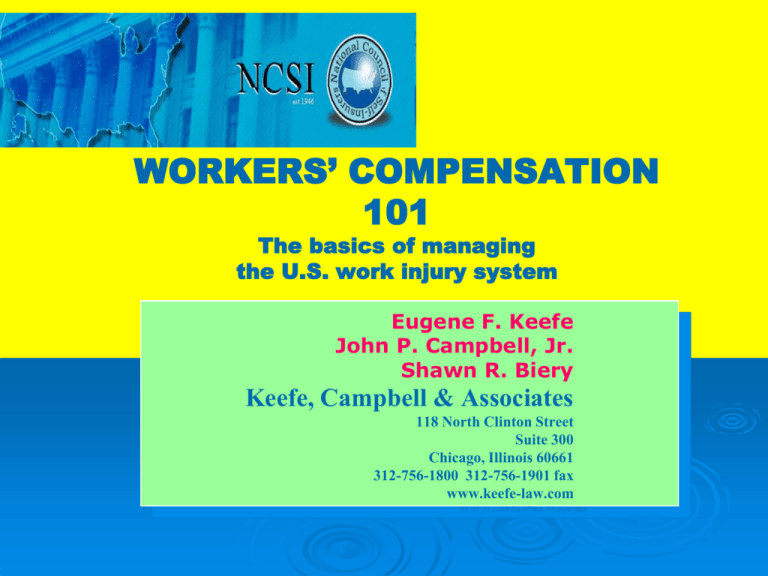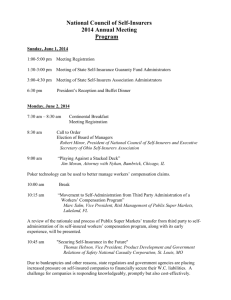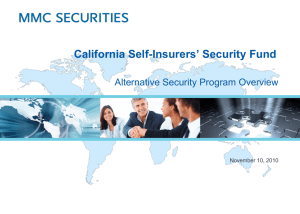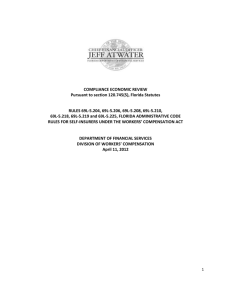1999 Nestlé Year-End Illinois Workers' Compensation
advertisement

WORKERS’ COMPENSATION 101 The basics of managing the U.S. work injury system Eugene F. Keefe John P. Campbell, Jr. Shawn R. Biery Keefe, Campbell & Associates 118 North Clinton Street Suite 300 Chicago, Illinois 60661 312-756-1800 312-756-1901 fax www.keefe-law.com Defining Workers’ Compensation The term is misleading to all participants at every level Best defined as state-run work accident insurance or self-insurance Concept has been redefined as work accident/disability insurance WC should be simple: it is only three simple benefits National Council of Self-Insurers May 2011 2 WC Benefits simplified Compensation for medical expenses Compensation for lost wages 40-45% of all WC costs in all world WC systems and rising constantly Every expectation is this will continue to rise 30-35% of all WC costs in all systems Permanency compensation or “the settlement” Illinois is unusual for the many paths to receive it Many Illinois permanency benefits are uncapped or lifetime—very few states do this National Council of Self-Insurers May 2011 3 Understanding U.S. workers’ compensation delivery systems Some systems are pro-active The applicant Goes to a state agency The state agency ascertains eligibility in conjunction with the employer The state agency sets the amount and pays benefits The state agency cuts it off or closes the file Forms, forms, forms Some WC system are “reactive” and the state agency becomes involved when things break down—typically more litigation and claim costs in reactive systems National Council of Self-Insurers May 2011 4 “Self-effectuating” work comp concepts Many WC system are designed to be selfeffectuating As the employer, you have to learn of the accidental event in a stated time You have to investigate it You are supposed to accept/deny benefits You follow, manage and then close claim You report progress to the state agency National Council of Self-Insurers May 2011 5 To optimize outcomes, all U.S. employers should have OccHealth and ER link set before injury Before starting work, do search for ER and OccHealth for each of your work sites/plants Consider WC PPO’s, if possible in your state Make sure the medical providers know your business, work rules and light work program Synchronize your medical release protocol Confirm you will be using triangle approach Always get faxed medical updates National Council of Self-Insurers May 2011 6 What to Do Upon Learning of Claim of Injury Where necessary, stabilize emergency situation Call for trained cleanup to prevent additional injuries/exposures without unnecessarily affecting needed accident investigation Preserve the evidence Have clear chain of command on all claims Institute and complete accident investigation Transmit report of event ASAP Utilize medical authorizations in all claims Assign responsible person to follow claim National Council of Self-Insurers May 2011 7 Always get HIPAA/GINA compliant-release signed Best way to check if medical release is HIPAA compliant—does it allow employee to withdraw consent? Many managers feel WC exception to HIPAA means such releases unnecessary in WC setting We disagree and urge all risk managers to get them You need to HIPAA release to access past medical info, not just current WC care You need fluid access to medical records and bills If employee won’t sign or withdraws consent, no shooting allowed National Council of Self-Insurers May 2011 8 Jurisdiction - Is the Loss Covered by the your state WC Act? This concept hits multi-state and/or federal coverage of work accidents It is possible to get benefits from two states or concurrent state and federal benefits Employer gets credit for whatever is paid Main jurisdiction concepts Injured in state; entitled to that state’s WC benefits Hired in state but injured outside state; may be entitled to WC benefits while employed for that employer Hired outside state, injured outside state; may be entitled to WC benefits if employee’s work “centered” in a given state National Council of Self-Insurers May 2011 9 Is this an “Employee?” When is it employee versus independent contractor? Lots of factors to choose from Who has the WC insurance for risk/loss “Control” of the job Tools used Method of payment—lump sum w/1099 or hourly Uniforms/names on equipment New concern for risk managers, “misclassification” of independent contractors Most important may be who has WC insurance coverage National Council of Self-Insurers May 2011 10 Total absence management Always have a goal—after accident investigation, target return to work at light and full duty Never let them “get away” or disappear—confirm all employees need to stay in touch at least weekly for all conditions whether due to work or not Remember, you don’t always know condition/absence is work-related but it costs money for employees to be off Fight for ‘top-down’ management approach in managing absences Confirm for your employees they are important and need to remain part of your organization while off work National Council of Self-Insurers May 2011 11 Is this an “Accident” covered by state WC Act? AOO/ICO; to be compensable an accident has to arise out of and happen in the course of ICO is easier to understand At some point, an employee is working or near work or around their job—ICO blurs with “remoting in” and new technology; accident investigation is crucial AOO is more difficult to ascertain Injury has to arise from risk associated with employ Employee has burden but you have to lock in facts to avoid later manipulation by counsel Repetitive trauma blurs all of it National Council of Self-Insurers May 2011 12 Traditional Accident Defenses/Quirks Not your state’s WC claim—other state or fed? Not your Employee? Liar, liar, pants on fire? Horseplay? Failed to provide required notice of accident? Idiopathic condition? Statute of Limitations? Fights--Aggressor rule? Intentional injuries to self/suicide? Commission of crimes? Alcohol/drug abuse causing or contributing to injury? Safety violation? Fall-downs without proof of increased risk? National Council of Self-Insurers May 2011 13 How to “Win” WC claims Start with accident investigation Time, place and date of injury Tell me what happened in own words and language Nature of injury (sprain, fracture, etc.) State all body part(s) affected Any previous injury to the affected body part(s) State source of injury--machines, hand tools, buildings State closest human to you, next closest person State all witness’ names Specific work process involved (lifting, carrying, etc.) Name all parties whom was the injury reported State specific plant or work site Current weather conditions National Council of Self-Insurers May 2011 14 Going to the Max—Using that webcam or camcorder First, always check your surveillance videos at site Next, turn over rocks and take statements Try to conduct interviews in nonadversarial setting Insure witness consents on tape Allow the witness to talk--ask open-ended questions No conclusions—follow the five senses Do not rush the witness List the date, time and location of the statement Safely reenact the accident/claim Take the recorded statement ASAP after the injury If you need interview questions, send a reply National Council of Self-Insurers May 2011 15 After accident investigated, set targets for medical care and RTW If you aren’t sure of solid targeting, talk to adjuster, NCM or veteran defense attorney Make targets reasonable Drive them to happen with UR IMEs Surveillance Weekly meetings with employee Then drive file to closure via settlement in appropriate claims National Council of Self-Insurers May 2011 16 Workers’ Compensation Triangle Critical first step: Complete accident investigation ASAP Critical second step: Get HIPAA authorization signed Critical third step: Have designated medical manager/claims handler contact treating physician to confirm: Authorization for contact on behalf of injured worker Agreement for continuing progress updates Learn diagnosis and treatment plan with • Projected MMI • Projected RTW modified duty • RTW full duty National Council of Self-Insurers May 2011 17 Make the Triangle Work Confirm Physician’s Return to Work Projection with the Three Sides of the Triangle in writing Your supervisor OccHealth or treating physician(s) Your employee Drive All Sides of the Triangle to Make the RTW Projection a Reality Stay in constant touch with the employee Have disability checks picked up at work If you don’t hear from the employee within your protocol, stop paying benefits National Council of Self-Insurers May 2011 18 Keep your friends close; keep your enemies closer Normally, when you have a disputed claim, tendency is to avoid employee—we should actually do the opposite Never, ever trust the workers’ compensation system to work in your best interests in a disputed claim Stay in contact at least weekly When you talk with the injured employee, check to insure Bills are being paid They are receiving disability checks They are progressing along expected medical recovery path National Council of Self-Insurers May 2011 19 How to Settle Claims and Get the Best Outcome with or without litigation As targets for MMI and RTW are reached, consider settlement and closure Litigated claims, never, ever ask for a demand; do your homework and make reasonable offers and then push for hearing Have solid defense attorneys provide appropriate range and values for offer National Council of Self-Insurers May 2011 20 Have you got the time for Enforced Accident Reporting?? Sign-in Sheet for Wedidn’thurtyou.com, Inc. I am injury free and have not been involved in any work accidents or injuries other than as listed. I am physically able to perform all work assignments without accommodation I understand I am to report all work accidents or physical problems, no matter how minor to my supervisor immediately. Name Date of last work injury (no matter how minor) _____________________________ ______________________________ _____________________________ ______________________________ National Council of Self-Insurers May 2011 21 Understanding Medicare/CMS Can’t settle WC claims any longer without considering Medicare’s interests Medicare approval of WC settlement for claims settling for $250,000.00 Reasonable expectation of impending Medicare eligibility Need to create Medicare set-aside to insure injured worker has money to pay future medical bills Need to submit to CMS for approval with settlement contract ‘Super-lien’ enforcement National Council of Self-Insurers May 2011 22 Summary Safety first--avoid accidents at all costs Have your OccHealth system in place If claim arises, move to investigate and set targets Get authorizations and set up the WC triangle Investigate Contact MD for RTW/MMI goal Confirm goal to employee/supervisor Make goal happen Make the targets work for you Bring the claim to closure National Council of Self-Insurers May 2011 23 Keefe, Campbell & Associates One of Illinois’ top defense trial firms Handling defense of general liability and employment law matters in Northern Illinois Handling workers’ comp defense throughout Illinois 24-hour email hotline for defense information and advice at ekeefe@keefe-law.com Regular email updates on all Illinois and Federal laws and appellate cases for all interested parties National Council of Self-Insurers May 2011 24



